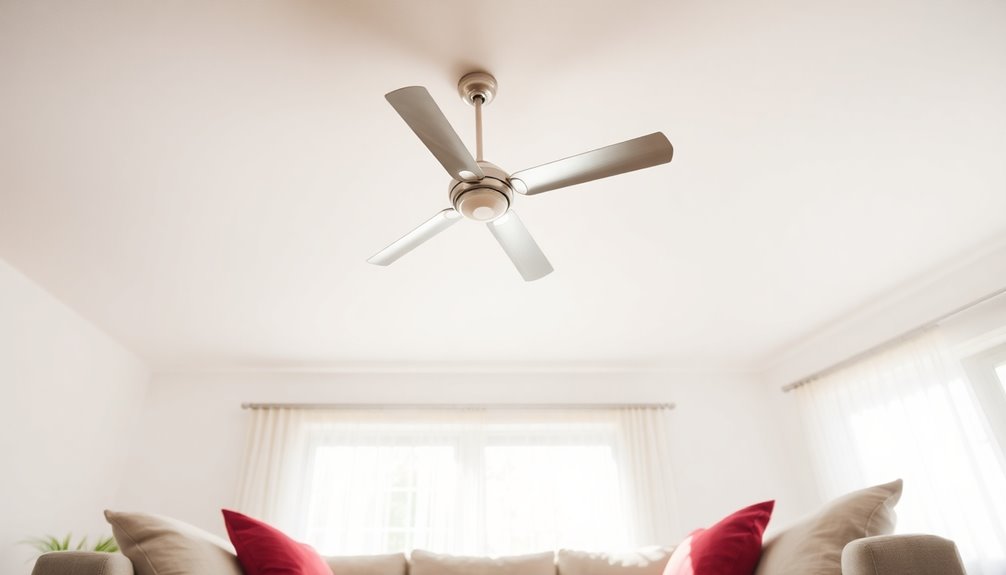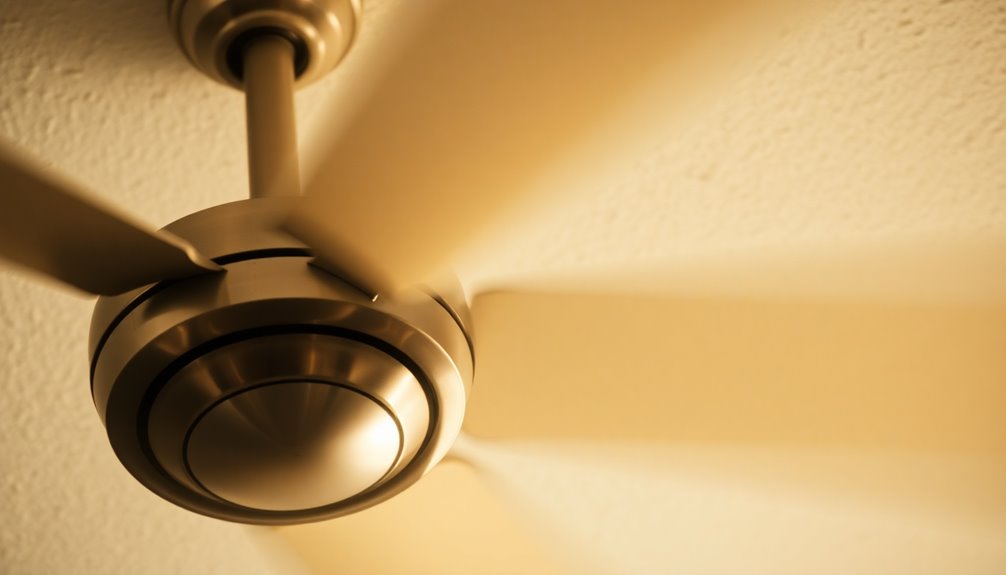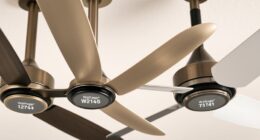A wobbly ceiling fan won't automatically fall, but it does indicate underlying issues that could compromise its stability. Loose screws, misaligned blades, or even dust accumulation can throw off the fan's balance. If you ignore the wobble, you increase the risk of accidents, especially if the fan vibrates at high speeds. To prevent potential hazards, guarantee your fan is securely mounted and regularly inspect it for problems. Taking these precautions can keep your fan safe. Want to know how to fix the wobbling and guarantee your fan remains stable? There's more important information coming up next.
Key Takeaways
- Wobbling can indicate loose mounting or misalignment, increasing the risk of the fan detaching and falling.
- Proper installation with secure junction boxes significantly reduces the chances of a ceiling fan falling.
- Regular maintenance, including tightening screws and inspecting for damage, helps prevent wobbling and potential falls.
- If a fan wobbles excessively, it may pose a danger, especially if it's heavy and operating at high speeds.
- Safety cables can be used for heavier fans to minimize fall risks, even if wobbling occurs.
Understanding Ceiling Fan Mechanics

When you turn on a ceiling fan, an electric motor spins the blades to create airflow. The design of the fan includes components like the blade holder, which connects the fan blades to the motor. If these blade holders aren't securely fastened, you may notice your fan becoming wobbly during operation.
This wobbling can often be traced back to loose screws or imbalances in blade alignment and weight distribution. To maintain peak performance, it's crucial to regularly check the tightness of all screws and verify the fan blades are aligned properly.
Dust buildup can also contribute to imbalance, leading to further wobbling. Keep in mind that a properly installed ceiling fan, mounted with a secure junction box rated for fan use, is unlikely to fall, even if it wobbles.
Understanding these mechanics can help you take proactive steps to improve the safety and efficiency of your fan. Regular maintenance not only prevents wobbling but also extends the lifespan of your ceiling fan, allowing you to enjoy a cool breeze without worry.
Taking care of these details makes a significant difference in your fan's performance.
Causes of Wobbling Ceiling Fans

Wobbling ceiling fans can stem from several common issues, and understanding these causes is key to maintaining stability.
Bent blade irons, warped blades, and mismatched blade sizes can all disrupt the balance needed for smooth operation.
Additionally, dust accumulation can add weight to the blades, further exacerbating wobbling and affecting performance.
Common Wobble Causes
Several factors can cause your ceiling fan to wobble, disrupting its performance and potentially leading to further issues.
One common cause is misaligned blades. If the blades aren't evenly spaced or properly angled, you'll notice a wobbly ceiling fan that struggles to maintain balance.
Additionally, loose screws can create instability. If the screws securing the blade holders or the fan itself aren't tightened, this can lead to excessive wobbling during operation.
Another factor to take into account is bent blades. Even a slight bend can disrupt the fan's balance, causing uneven spinning.
Over time, warping of the blades can occur, leading to a mismatch in weight distribution that contributes to wobbling. If your fan has different blade sizes or weights, this imbalance can further exacerbate the problem.
Finally, it's crucial to check for dust accumulation on the blades. While this will be discussed later, it's worth noting that debris can affect balance and make your ceiling fan wobble even more.
Impact of Dust Accumulation
Accumulated dust on ceiling fan blades can considerably affect their performance and stability. When dust accumulation builds up, it disrupts the balance of the blades, causing your fan to wobble during operation. The added weight of dirt makes the blades sag, which only increases the wobble and negatively impacts airflow.
Even a thin layer of dust can alter the aerodynamics of the blades, leading to uneven air distribution that exacerbates the wobbling ceiling fan issue.
Regularly cleaning ceiling fan blades is crucial to prevent this dust build-up. If you neglect to clean your fan, you may find it wobbling more than usual, leading to higher energy consumption due to inefficient airflow.
A clean fan operates smoothly and efficiently, providing ideal airflow without any annoying shakes or vibrations. Make it a habit to wipe down your fan blades every month or so to maintain their balance and performance.
Risks of Wobbly Ceiling Fans

Experiencing a wobbly ceiling fan can be concerning, as it raises questions about safety and stability. While the risk of an entire fan falling is low, especially if it's properly installed, wobbling can indicate underlying issues that you shouldn't ignore. Heavy fans moving at high speeds can pose a danger, so ensuring proper installation is essential to minimize risks.
One of the main risks associated with wobbly ceiling fans is the potential for light fixtures to loosen over time. If your fan wobbles, the vibrations may gradually cause these fixtures to detach, leading to falling debris that could injure someone below. It's not just the fan itself you need to worry about; the surrounding elements can also become hazardous. Regular cleaning and maintenance can help you identify any problems before they escalate. Keeping an eye on the installation and ensuring everything is secure can greatly reduce the risks associated with a wobbly ceiling fan.
Fixing a Wobbly Ceiling Fan

If you've noticed your ceiling fan wobbling, it's important to address the issue promptly to maintain safety and functionality. Start by turning off the electricity supply to your fan.
Then, inspect all mounting screws and connections for tightness, as loose screws can contribute to wobbling. Tighten any loose mounting screws in the motor housing and check the blade alignment. If the blades are misaligned, adjusting them can greatly reduce wobbling.
Next, clean the fan blades to remove dust and debris, which can add weight and affect balance.
If wobbling persists, consider using a blade balancing kit. This kit typically includes clips and adhesive weights to stabilize uneven blades and fix a wobbly ceiling fan effectively.
Finally, inspect the blade holders and connections for any bending or warping. Damaged components can lead to imbalance and may require replacement.
Installation Guidelines for Safety

Proper installation is key to ensuring your ceiling fan operates safely and effectively. Start by following proper installation guidelines: mount your fan at a height of at least 8 to 10 feet from the floor. This height minimizes risks associated with a wobbling fan while promoting ideal air circulation.
Next, secure the mounting bracket to solid wooden joists. If your support is inadequate, it can increase the risk of wobbling and potentially lead to fan failure. Always maintain a minimum clearance of 7 feet between the fan blades and the floor to prevent accidents, especially in residential settings.
It's also essential to follow the manufacturer's guidelines, including using junction boxes rated specifically for ceiling fans. This greatly reduces the likelihood of accidents related to a wobbling fan.
Don't forget, regular inspections every six months can help you identify loose screws or misalignments that may cause wobbling. By prioritizing these installation guidelines, you can enjoy your ceiling fan's benefits without worrying about safety risks.
Importance of Regular Maintenance

Regular maintenance of your ceiling fan is essential for its longevity and safety.
By performing inspections every six months, you can catch issues like wobbling early and prevent more serious problems.
Keeping the blades clean and checking all connections guarantees your fan operates smoothly and efficiently. Additionally, ensuring proper air quality can contribute to a healthier living environment while using ceiling fans for circulation.
Preventive Maintenance Practices
Consistently maintaining your ceiling fan is vital for guaranteeing its longevity and safe operation. By practicing preventive maintenance, you can prevent issues before they escalate, especially if your ceiling fan is wobbling. Regular maintenance not only enhances performance but also reduces safety risks.
To keep your ceiling fan in top shape, consider these key practices:
- Tighten screws and connections: Regularly check and tighten all screws to guarantee secure mounting, which minimizes wobbling.
- Dust the blades: Periodic dusting helps maintain balance. Accumulated dust can cause blades to sag and wobble over time.
- Inspect every six months: Look for alignment issues and signs of wear. Early detection can help you address problems before they become serious.
Additionally, verify that your junction box is securely mounted and rated for ceiling fan support. This is vital for preventing accidents, even if the fan is wobbling.
If you're unsure about maintenance or repairs, consider hiring a professional electrician. They can enhance your fan's safety and performance, giving you peace of mind.
Regular Safety Inspections
Conducting safety inspections every six months is crucial for keeping your ceiling fan in prime condition.
During these inspections, you should carefully inspect the screws and verify they're tightly fastened. Loose screws can lead to wobbling, which not only affects performance but can also pose a safety risk.
Check the blades for alignment, as misaligned blades can also contribute to instability. Dust accumulation can throw off the balance, so routine cleaning is essential to maintain peak performance.
It's also a good idea to inspect the mounting hardware and junction box to confirm that your fan is securely installed.
Comparing Ceiling Fan Types

When selecting a ceiling fan, you'll often find yourself comparing three main types: standard, low-profile, and outdoor. Each type is tailored to specific ceiling heights and locations, making it essential to measure the distance from the floor to your ceiling before purchasing.
- Standard ceiling fans are perfect for rooms with higher ceilings, mounted 8 to 10 feet above the floor for ideal air circulation.
- Low-profile ceiling fans are designed for rooms with low ceilings, ensuring the fan blades sit at least 7 feet from the floor to avoid safety hazards.
- Outdoor ceiling fans can withstand moisture and humidity, making them ideal for covered patios and porches. They come in wet-rated and damp-rated options to suit your needs.
When choosing your indoor ceiling fans, consider not only the height of your ceiling but also the room's purpose. Additionally, modern Energy Star certified fans can raise thermostat temp by 4°F, promoting energy savings while enhancing comfort.
Energy-efficient ceiling fans can considerably reduce electricity costs, using less power than air conditioning units while still providing effective air circulation.
Fan Safety Features to Consider

Choosing the right ceiling fan goes beyond just style and size; safety features are equally important. When selecting a fan, consider safety cables, especially for heavier models. These cables act as a backup, preventing the fan from falling if the main mounting fails.
Ensure that your fan is installed using junction boxes rated for ceiling fan support. This guarantees stability, reducing the risk of wobbling or detachment during operation.
Additionally, if you're placing the fan in a room with low ceilings or near beds, installing guards or screens can provide extra protection.
Mount your fan at a height of at least 2.1 meters from the floor to minimize the chance of injury from accidental contact.
Benefits of Proper Installation

Proper installation of ceiling fans not only enhances their performance but also greatly boosts safety. When you guarantee that your ceiling fan is properly installed, you're reducing the risk of accidents and guaranteeing a comfortable environment. Here are a few key benefits:
- Securely mounted: Proper installation means your fan is attached to a junction box rated for fan support, minimizing the chance of it falling.
- Adequate clearance: Installing your fan at the recommended height of 8 to 10 feet prevents hazards from low-hanging fans, keeping you and your family safe.
- Reduced wobbling: Using solid wooden joists for mounting stabilizes the fan, combating wobbling that can occur from inadequate support.
Additionally, regular maintenance and inspections every six months can help spot issues before they become serious hazards. Furthermore, ensuring your fan is one of the best airflow ceiling fans can enhance cooling and reduce wobbling due to balanced design.
Guaranteeing all screws and connections are tight during installation is essential, as loose fittings are a common cause of wobbling and potential risks.
Frequently Asked Questions
How to Know if a Ceiling Fan Will Fall?
To know if a ceiling fan will fall, you should check its installation. Verify it's securely mounted to a junction box rated for fan support.
Look for signs of wear or damage, like loose screws or bent blades. Regularly inspect the fan for wobbling, which can indicate misalignment.
Maintaining proper clearance and height can also help prevent accidents. If you notice excessive wobbling, it's best to address it promptly for safety.
Is It Okay for a Ceiling Fan to Wobble?
Imagine riding a bike with a slightly wobbly wheel; it can be unsettling, but it usually won't throw you off.
It's okay for your ceiling fan to wobble a bit, especially at higher speeds. This slight wobble often stems from misaligned blades or loose mounts.
Regular maintenance, like tightening screws and ensuring blade alignment, helps minimize this issue.
Just remember, as long as it's securely installed, you're generally safe!
Will a Wobbling Fan Fall?
If you notice your ceiling fan wobbling, don't panic; it's unlikely to fall. Wobbling usually means there's an imbalance or loose part, not that it's improperly installed.
Verify the fan's mounted securely to a rated junction box, and check for any loose screws or components.
Regular maintenance and inspections can help you catch these issues early. So, keep an eye on it, and you'll minimize any potential risks.
What Are the Odds of a Ceiling Fan Falling?
Ceiling fans have a way of swaying gracefully, but you might wonder about their reliability. The odds of a ceiling fan falling are quite low, especially when it's properly installed.
While wobbles can be annoying, they usually stem from minor issues like loose screws or bent blades, not a recipe for disaster.
Regular maintenance keeps things in check, ensuring your fan stays where it belongs—safely above you, adding comfort to your space.
Conclusion
In the dance of your ceiling fan, a little wobble can feel like a gentle sway, but it's essential to address it before it turns into a dramatic tumble. With a few adjustments and regular care, you can keep your fan gliding gracefully above you. Embrace the rhythm of proper installation and maintenance, and let your fan serenade you safely through the seasons, ensuring that it remains a beautiful fixture in your home, not a cause for concern.









